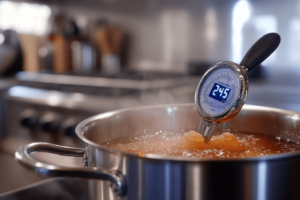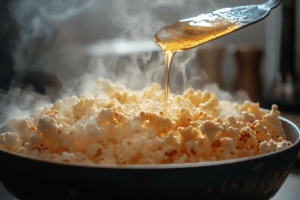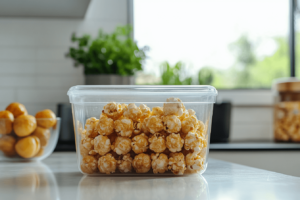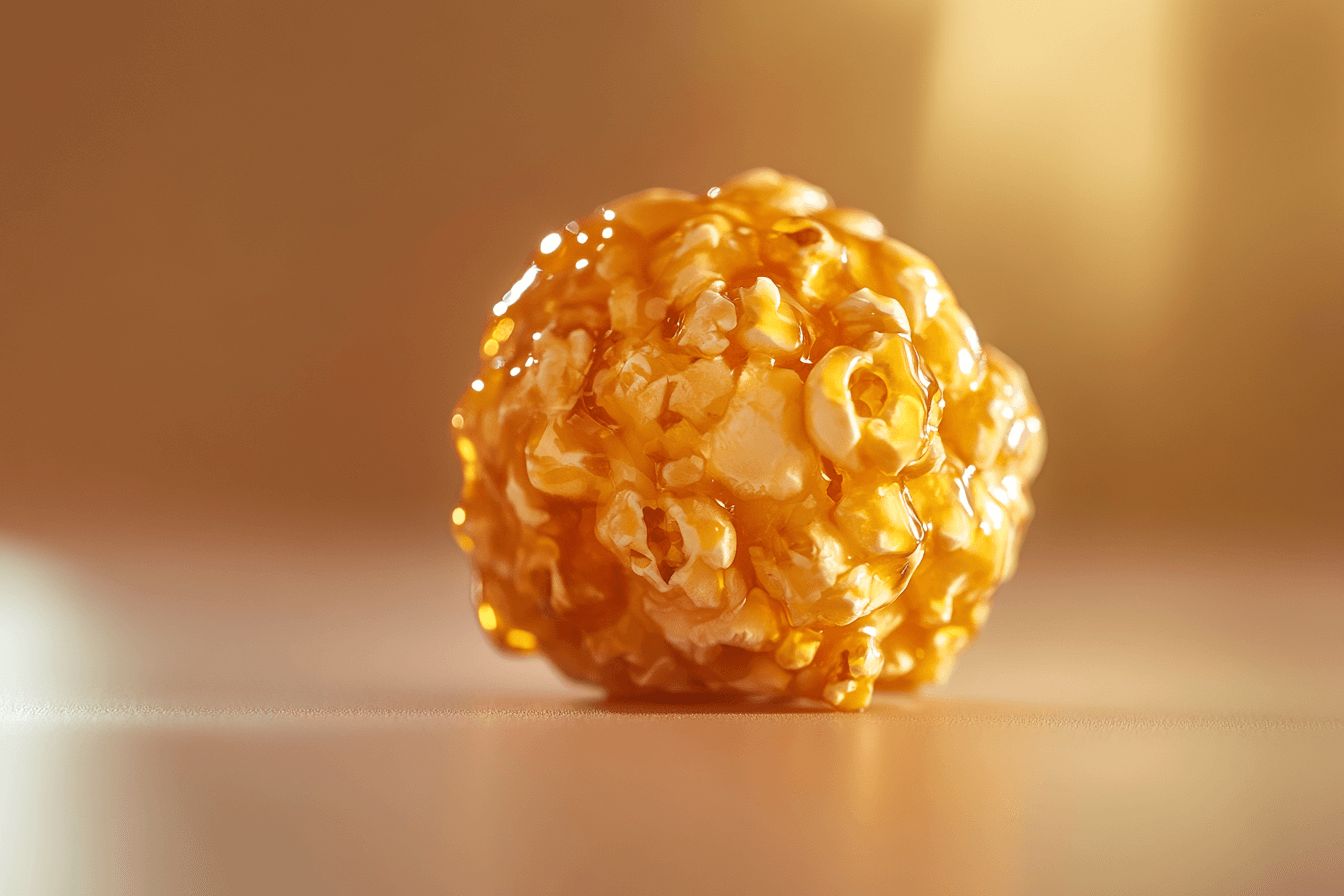Everyone loves a sweet snack that is fun to eat and easy to share. Popcorn balls fit that description. They can be crunchy, satisfying treats that instantly remind us of cozy movie nights and festive celebrations. Yet, there are times when your popcorn balls turn out chewy or sticky instead of firm and crisp. This can be frustrating, especially if you spent time measuring ingredients and cooking them carefully. In this article, we will explore the main reasons behind chewy popcorn balls and share tips to avoid this common mishap. Furthermore, we will cover simple methods you can use to keep your popcorn crunchy and delicious.
Reasons Your Popcorn Balls Turn Out Chewy
It is natural to wonder why your popcorn balls feel soft or rubbery. Usually, the problem arises when the sugar syrup you use is not cooked to the right temperature, or when there is too much moisture. Moreover, the type of popcorn you use and how you store these treats also matter. Below, we will examine each of these possible causes in detail.
Improper Sugar Syrup Temperature
Your sugar syrup must reach the right temperature to form crunchy popcorn balls. When you heat sugar, it goes through different stages. If you do not reach the firm ball stage (around 245°F to 250°F), the syrup will remain soft. Thus, your popcorn balls might turn out chewy. It helps to use a candy thermometer, since guessing or relying on approximate cooking times may lead to inconsistent results.

Moreover, some cooks heat sugar too fast and scorch it. If the syrup caramelizes too much, your popcorn balls might taste burnt. They might also become tough on the outside while staying sticky inside. It is important to heat the sugar slowly to ensure even cooking.
Excess Moisture or Humidity
Moisture is a big enemy of crunchy popcorn. Even if you cook the sugar syrup perfectly, your environment can affect the final texture. High humidity levels can make your popcorn balls absorb extra moisture from the air. As a result, they become chewy or sticky soon after you store them.
To tackle this issue, try working in a dry kitchen or at least reduce sources of steam and humidity when making these treats. You can also store them in airtight containers with a small packet of silica gel to keep the air inside as dry as possible. Furthermore, letting them set in a cool, dry spot helps maintain their crispness.
Using the Wrong Popcorn
Selecting the right popcorn kernels can make a big difference. Some kernels pop into smaller, denser pieces, while others yield large, fluffy pieces that are perfect for popcorn balls. Thus, you should look for “mushroom” or “ball-shaped” popcorn kernels if you want consistent, round pieces.
In addition, stale popcorn kernels often pop unevenly. This can result in half-popped kernels that are chewy and unpleasant. So always start with fresh kernels from a trusted brand. Also, popping your corn right before you form the balls helps preserve its crunch.
Mixing Technique and Timing
The way you combine syrup and popcorn affects the final outcome. You should coat the popcorn evenly, but you must move quickly. Once the syrup hits the cooked popcorn, you only have a short window before it hardens. If you wait too long, the syrup may cool too much and become thick, forcing you to add extra moisture or reheat it. Both actions can lead to chewy popcorn balls.

Furthermore, be gentle when mixing. Crushing the popcorn can cause excess starch to mix with the syrup. This might create a sticky mixture, which is difficult to shape or handle. Using a wide bowl and a rubber spatula can help you fold the syrup more effectively without breaking too many kernels.
Not Letting the Popcorn Cool Properly
Some recipes call for you to lightly warm the popcorn before adding syrup. This can make it easier to stir everything together. However, if you add hot syrup to hot popcorn, you might trap steam within the mixture. That excess steam can result in a chewy texture.
Instead, let your popcorn cool to room temperature. Next, pour your hot syrup slowly while mixing gently. This approach keeps steam at bay. Moreover, do not cover the popcorn balls immediately after shaping them. Let them rest on a tray lined with parchment paper until they feel firm and cool to the touch. Only then should you wrap or store them in containers.
How to Avoid Chewy Popcorn Balls
There are several steps you can take to prevent chewy popcorn balls. First, always use a reliable candy thermometer to ensure you reach the correct sugar stage. Then, select fresh, high-quality popcorn kernels. Next, pay attention to your mixing technique, since overmixing can break kernels and release unwanted starch. Finally, store your popcorn balls in a cool, dry place with as little humidity as possible.
Cook Your Sugar Syrup Correctly
It is wise to heat the sugar mixture to 245°F–250°F, often referred to as the firm ball stage. You can test this by dropping a small amount of syrup into ice-cold water. If it forms a firm but pliable ball, you are in the right zone. If it spreads out or looks soft, cook it longer. However, do not crank the heat too high to speed things up. A slow, steady boil ensures consistent cooking.
Moreover, keep stirring the sugar mixture carefully. However, do not stir too aggressively, or you might create sugar crystals on the sides of your pan. To prevent crystallization, you can also wipe the pan edges with a damp pastry brush. This approach helps keep your syrup clear and smooth, leading to a better popcorn coating.
Choose Quality Kernels and Pop Them Properly
Always buy kernels from a reputable brand. Look for varieties labeled as “mushroom” popcorn if you want a sturdy shape. Also, test small batches to ensure the kernels pop well. Throw out any old or stale kernels, as they can result in half-popped bits that ruin the texture.
Try popping your corn in a pot with a little oil. Heat the oil until you notice one or two kernels popping. Then, add the rest of your kernels and cover the pot. Shake the pot occasionally to avoid scorching. As soon as popping slows to about two seconds between pops, remove the pot from heat. Moving quickly keeps your popcorn from burning and from absorbing extra oil.
Manage Your Mixing Process
Once you have your fresh, fully popped corn ready, place it in a big bowl. Pour your hot syrup in a steady stream while gently folding with a rubber spatula or large wooden spoon. Working in small batches helps you coat each piece without damaging the popcorn. Indeed, gentle handling is key if you want a uniform coating.
After the popcorn is coated, shape the balls by hand while the mixture is still warm. You can wear clean kitchen gloves or lightly oil your hands to keep the syrup from sticking. Press the popcorn together just enough to form a solid ball, but do not press too firmly. Overly compacted popcorn will lose its fluffiness and become dense.
Store Popcorn Balls Correctly
Proper storage is essential. Let your popcorn balls cool fully before packaging. After they have set, wrap them individually in plastic wrap or place them inside airtight containers. Keep them in a cool spot, away from heat or moisture. If you live in a humid area, you might include a small desiccant packet in your container. This step helps absorb excess moisture, preserving crispness.

Moreover, avoid stacking the balls on top of each other. If possible, lay them in a single layer with parchment paper between each layer. Stacking can trap moisture and cause them to stick together. It can also crush the popcorn at the bottom, which leads to chewy, flattened spots.
Why Are My Popcorn Balls Sticky?
Sticky popcorn balls are often a sign of too much liquid or an undercooked syrup. Furthermore, if you used a syrup recipe that contains extra ingredients like chocolate, caramel, or peanut butter, you may need to adjust the cooking time to reach the correct temperature. Indeed, the added fats or sugars can change how quickly the mixture solidifies.
In some cases, humidity is the main culprit. Even if your syrup was perfect, storing the popcorn balls in a damp environment leads to stickiness. Thus, your best strategy is to place them in a dry, sealed container.
Checking for Stickiness During Cooking
If your recipe contains molasses, honey, or another liquid sweetener, you might experience a different sugar stage. For that reason, pay attention to the consistency of the syrup on your spatula. If it runs off too quickly, it is likely too thin. If it drips off slowly in strands, you are closer to the right stage. Yet, you should still use a candy thermometer for accuracy.
Once you remove the syrup from heat, move fast. Overcooking can lead to a hard, brittle coating that is more prone to cracking. Balancing the right texture ensures a crisp exterior without excessive tackiness.
Simple Fixes for Chewy Popcorn Balls
If you find yourself with chewy popcorn balls, do not panic. There are a few quick fixes you can apply.
- Reheat the Balls in the Oven
Place them on a lined baking sheet and warm at a low temperature (around 250°F) for 10 minutes. Keep a close eye on them. This process can help draw out extra moisture, making the balls less chewy. However, be careful not to melt the sugar too much, or you may end up with a sticky mess. - Add a Coating of Chocolate or Candy Shell
Sometimes, sealing the popcorn with a thin coating of chocolate can preserve crispness. Melt chocolate, dip or drizzle the popcorn balls, and let them firm up. This acts like a protective shell that keeps moisture out. - Work in a Less Humid Environment
If you notice your kitchen is quite humid, try a drier room or wait until humidity levels drop. You can also run a dehumidifier or an air conditioner to reduce moisture. - Store with Care
Wrap each ball tightly in plastic wrap, then keep them in a sealed container. Add a small silica packet if you live in a humid area. These small details make a major difference in preserving the crunch.
Best Ingredients for Crunchy Popcorn Balls
Choosing the right ingredients gives you the best chance at success. Here are a few ingredient tips to keep in mind:
- Sugar: White granulated sugar works well for clear syrups. Brown sugar adds deeper flavor, but it can increase moisture.
- Corn Syrup: Light corn syrup helps stabilize the sugar mixture and reduces crystallization. If you prefer a different sweetener, be mindful of changes in cooking times.
- Butter: Adding a bit of butter can create a richer flavor and a smoother texture. However, too much fat might soften the coating.
- Flavorings: Vanilla extract, spices, or small amounts of salt can elevate the taste. Yet, do not go overboard. Extra liquid flavorings can affect the sugar stage.
Furthermore, you can experiment with add-ins like nuts, dried fruit, or candy pieces. Just make sure these additions do not contain too much moisture or oily residue, which might lead to a soft, chewy feel.
Frequently Asked Questions
What is the 3 second rule for popcorn?
The 3 second rule means you should take your popcorn off the heat when there are about 3 seconds between pops. This ensures the popcorn does not burn and stays fluffy.
Why are my popcorn balls sticky?
They are often sticky because your syrup might be undercooked or you used too much liquid. Humidity can also affect the texture and create stickiness.
Why is my popcorn chewy instead of crunchy?
Popcorn turns chewy when moisture is trapped. Inadequate sugar syrup temperature or high humidity can cause this. Storing it in a sealed, dry container helps keep it crunchy.
How do you keep popcorn from getting chewy?
Store popcorn in airtight containers, use the correct sugar temperature, and avoid humid kitchens. Also, let it cool thoroughly before sealing it away.
Conclusion
Popcorn balls should be a delight to munch on—crisp, sweet, and full of flavor. If yours are turning out chewy, remember that proper sugar syrup temperature, fresh popcorn kernels, and the right storage conditions are critical. Moreover, working quickly and gently while mixing helps prevent crushed kernels or unwanted moisture. By following these tips, you can transform sticky or soft popcorn balls into crunchy treats that make any snack time or holiday celebration more enjoyable. Indeed, once you master these techniques, you will find it simpler to whip up perfect popcorn balls time after time.

